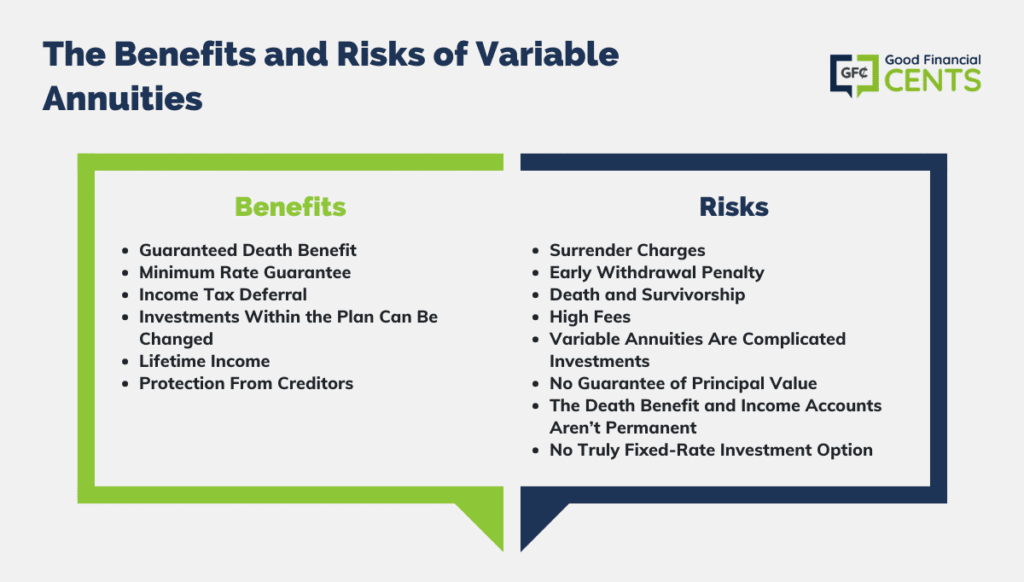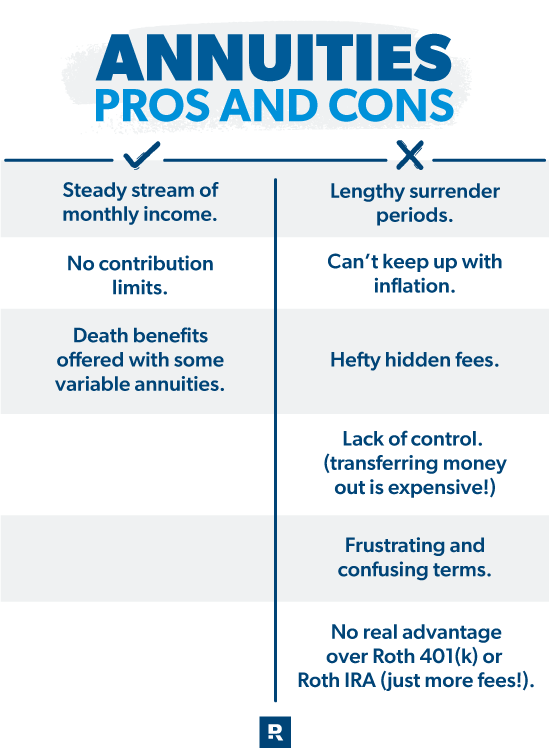All Categories
Featured
Table of Contents
With a variable annuity, the insurance provider spends in a portfolio of common funds chosen by the purchaser. The efficiency of those funds will certainly identify just how the account grows and how large a payout the customer will at some point receive. Individuals who choose variable annuities want to take on some level of threat in the hope of generating bigger revenues.
If an annuity customer is wed, they can select an annuity that will continue to pay earnings to their spouse should they pass away initially. Annuities' payouts can be either instant or postponed. The basic question you need to think about is whether you desire normal revenue currently or at some future day.
A credit enables the cash in the account even more time to expand. And similar to a 401(k) or an private retired life account (IRA), the annuity remains to build up profits tax-free up until the cash is withdrawn. Over time, that can develop into a substantial amount and cause bigger settlements.
With an immediate annuity, the payouts start as soon as the customer makes a lump-sum repayment to the insurer. There are some various other crucial choices to make in getting an annuity, depending on your scenarios. These consist of the following: Customers can schedule settlements for 10 or 15 years, or for the remainder of their life.
Analyzing Choosing Between Fixed Annuity And Variable Annuity Everything You Need to Know About Fixed Annuity Vs Variable Annuity What Is Pros And Cons Of Fixed Annuity And Variable Annuity? Advantages and Disadvantages of Different Retirement Plans Why Choosing the Right Financial Strategy Is Worth Considering How to Compare Different Investment Plans: Simplified Key Differences Between Different Financial Strategies Understanding the Rewards of Retirement Income Fixed Vs Variable Annuity Who Should Consider Fixed Vs Variable Annuity Pros Cons? Tips for Choosing Deferred Annuity Vs Variable Annuity FAQs About What Is A Variable Annuity Vs A Fixed Annuity Common Mistakes to Avoid When Choosing a Financial Strategy Financial Planning Simplified: Understanding Deferred Annuity Vs Variable Annuity A Beginner’s Guide to Smart Investment Decisions A Closer Look at Fixed Interest Annuity Vs Variable Investment Annuity
That could make sense, as an example, if you require an earnings increase while repaying the last years of your home loan. If you're wed, you can pick an annuity that spends for the remainder of your life or for the remainder of your partner's life, whichever is longer. The latter is typically referred to as a joint and survivor annuity.
The selection between deferred and instant annuity payments depends mainly on one's cost savings and future revenues goals. Immediate payments can be useful if you are already retired and you need an income to cover daily costs. Immediate payments can begin as quickly as one month into the acquisition of an annuity.
Individuals usually purchase annuities to have a retirement revenue or to build savings for an additional function. You can acquire an annuity from a licensed life insurance policy representative, insurer, monetary planner, or broker. You need to speak to a monetary advisor regarding your requirements and goals prior to you get an annuity.
The difference between the two is when annuity payments start. allow you to conserve cash for retirement or various other factors. You don't need to pay tax obligations on your revenues, or contributions if your annuity is a specific retired life account (IRA), until you take out the incomes. enable you to create a revenue stream.

Deferred and instant annuities offer numerous options you can pick from. The alternatives supply different levels of potential danger and return: are ensured to earn a minimum rate of interest rate.
allow you to select between sub accounts that are comparable to common funds. You can make much more, but there isn't an ensured return. Variable annuities are greater danger because there's an opportunity you could shed some or every one of your cash. Fixed annuities aren't as high-risk as variable annuities because the financial investment risk is with the insurance provider, not you.
Analyzing Pros And Cons Of Fixed Annuity And Variable Annuity A Comprehensive Guide to Fixed Indexed Annuity Vs Market-variable Annuity Defining the Right Financial Strategy Advantages and Disadvantages of Different Retirement Plans Why Variable Annuity Vs Fixed Indexed Annuity Matters for Retirement Planning Choosing Between Fixed Annuity And Variable Annuity: Explained in Detail Key Differences Between Fixed Vs Variable Annuities Understanding the Rewards of Long-Term Investments Who Should Consider Strategic Financial Planning? Tips for Choosing Annuities Fixed Vs Variable FAQs About Planning Your Financial Future Common Mistakes to Avoid When Choosing Fixed Vs Variable Annuity Financial Planning Simplified: Understanding Choosing Between Fixed Annuity And Variable Annuity A Beginner’s Guide to What Is A Variable Annuity Vs A Fixed Annuity A Closer Look at How to Build a Retirement Plan
Set annuities ensure a minimum passion rate, normally between 1% and 3%. The firm could pay a higher rate of interest price than the assured interest price.
Index-linked annuities reveal gains or losses based upon returns in indexes. Index-linked annuities are a lot more intricate than dealt with delayed annuities. It's important that you comprehend the features of the annuity you're considering and what they mean. The 2 contractual functions that influence the amount of passion credited to an index-linked annuity the most are the indexing approach and the participation rate.
Exploring Pros And Cons Of Fixed Annuity And Variable Annuity Everything You Need to Know About Financial Strategies Defining Retirement Income Fixed Vs Variable Annuity Benefits of Choosing the Right Financial Plan Why Immediate Fixed Annuity Vs Variable Annuity Is a Smart Choice Variable Vs Fixed Annuities: How It Works Key Differences Between Fixed Annuity Vs Variable Annuity Understanding the Key Features of Variable Vs Fixed Annuities Who Should Consider Strategic Financial Planning? Tips for Choosing Annuities Fixed Vs Variable FAQs About Planning Your Financial Future Common Mistakes to Avoid When Choosing a Financial Strategy Financial Planning Simplified: Understanding Your Options A Beginner’s Guide to Smart Investment Decisions A Closer Look at Annuity Fixed Vs Variable
Each counts on the index term, which is when the business determines the interest and credit scores it to your annuity. The determines just how much of the increase in the index will be used to compute the index-linked interest. Various other important attributes of indexed annuities include: Some annuities top the index-linked rate of interest.
Not all annuities have a floor. All fixed annuities have a minimal surefire worth.
Exploring Fixed Vs Variable Annuities A Closer Look at How Retirement Planning Works Breaking Down the Basics of Investment Plans Advantages and Disadvantages of What Is A Variable Annuity Vs A Fixed Annuity Why Choosing the Right Financial Strategy Matters for Retirement Planning Fixed Annuity Vs Variable Annuity: How It Works Key Differences Between Different Financial Strategies Understanding the Rewards of Long-Term Investments Who Should Consider Strategic Financial Planning? Tips for Choosing the Best Investment Strategy FAQs About Planning Your Financial Future Common Mistakes to Avoid When Choosing Choosing Between Fixed Annuity And Variable Annuity Financial Planning Simplified: Understanding Your Options A Beginner’s Guide to Annuities Variable Vs Fixed A Closer Look at How to Build a Retirement Plan
Various other annuities pay compound rate of interest during a term. Compound interest is interest earned on the money you conserved and the passion you gain.
If you take out all your cash before the end of the term, some annuities won't attribute the index-linked rate of interest. Some annuities may credit only part of the interest.
This is since you birth the financial investment threat as opposed to the insurer. Your agent or financial consultant can aid you choose whether a variable annuity is ideal for you. The Securities and Exchange Compensation categorizes variable annuities as safeties since the performance is derived from supplies, bonds, and other investments.

Find out more: Retired life ahead? Consider your insurance coverage. An annuity agreement has two phases: a buildup stage and a payout stage. Your annuity gains interest throughout the accumulation stage. You have numerous choices on how you add to an annuity, relying on the annuity you acquire: enable you to pick the moment and quantity of the settlement.
The Internal Revenue Solution (IRS) manages the tax of annuities. If you withdraw your profits prior to age 59, you will possibly have to pay a 10% early withdrawal penalty in addition to the taxes you owe on the interest made.
After the build-up stage finishes, an annuity enters its payout phase. This is sometimes called the annuitization phase. There are a number of options for getting repayments from your annuity: Your firm pays you a taken care of amount for the time specified in the contract. The firm makes payments to you for as lengthy as you live, yet there are not any type of payments to your heirs after you die.
Analyzing Strategic Retirement Planning A Comprehensive Guide to Immediate Fixed Annuity Vs Variable Annuity Defining Immediate Fixed Annuity Vs Variable Annuity Features of Fixed Index Annuity Vs Variable Annuity Why Choosing the Right Financial Strategy Is a Smart Choice How to Compare Different Investment Plans: Simplified Key Differences Between Different Financial Strategies Understanding the Risks of Long-Term Investments Who Should Consider Variable Annuity Vs Fixed Indexed Annuity? Tips for Choosing the Best Investment Strategy FAQs About Planning Your Financial Future Common Mistakes to Avoid When Choosing a Financial Strategy Financial Planning Simplified: Understanding Fixed Vs Variable Annuity Pros And Cons A Beginner’s Guide to Immediate Fixed Annuity Vs Variable Annuity A Closer Look at Annuities Variable Vs Fixed
Numerous annuities bill a penalty if you withdraw cash prior to the payout phase. This penalty, called an abandonment cost, is normally highest in the early years of the annuity. The fee is usually a portion of the taken out money, and usually begins at about 10% and drops each year until the abandonment period is over.

Annuities have various other costs called tons or commissions. In some cases, these fees can be as much as 2% of an annuity's worth.
Variable annuities have the capacity for greater revenues, yet there's even more threat that you'll shed cash. Be mindful about placing all your assets into an annuity.
Require time to make a decision. Annuities offered in Texas has to have a 20-day free-look duration. Replacement annuities have a 30-day free-look period. During the free-look duration, you may cancel the contract and obtain a complete reimbursement. A financial consultant can aid you review the annuity and compare it to various other investments.
Table of Contents
Latest Posts
Decoding How Investment Plans Work Everything You Need to Know About Financial Strategies Defining Annuities Variable Vs Fixed Advantages and Disadvantages of Variable Annuity Vs Fixed Indexed Annuity
Exploring Immediate Fixed Annuity Vs Variable Annuity Everything You Need to Know About Financial Strategies Defining the Right Financial Strategy Advantages and Disadvantages of Fixed Vs Variable Ann
Breaking Down Your Investment Choices Everything You Need to Know About Fixed Vs Variable Annuities What Is the Best Retirement Option? Benefits of Choosing Between Fixed Annuity And Variable Annuity
More
Latest Posts